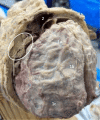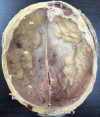Hyperostosis Fronto-Parieto-Occipitalis: A Cadaveric Case Report
- PMID: 37546094
- PMCID: PMC10403996
- DOI: 10.7759/cureus.41445
Hyperostosis Fronto-Parieto-Occipitalis: A Cadaveric Case Report
Abstract
Hyperostosis of the skull is a rare bone dysplasia described in disorders such as hyperostosis cranialis interna (HCI) and hyperostosis frontalis interna (HFI). Other syndromes presenting with hyperostosis include Morgagni-Stewart-Morel (MSM) and Troell-Junet. HCI is an abnormal hyperostosis of most endosteal skull and calvarium surface regions. A more specific hyperostosis, HFI, is an unusual bone growth based on its volume and porosity; it is primarily located bilaterally on the frontal portions of the calvarium. However, the hyperossification does not cross the superior sagittal sinus. Upon cadaveric dissection, we found hyperossification beyond the frontal area, extending to the parietal and occipital bones with the significant characteristic of no midline interference. Hyperossification results in gross indentations on the corresponding frontal, parietal, and occipital hemispheric brain tissues. This report discusses possible differentials for this rare cadaveric finding of frontal, parietal, and occipital bone hyperostosis. This case report includes some major characteristic features indicative of HCI and HFI with some interesting variations and features suggestive of MSM and Troell-Junet syndromes. Due to the lack of patient history and medical records, no further conclusions about clinical differentials, symptoms, or causative syndromes could be drawn; further research needs to be conducted on HCI, HFI, and related syndromes to understand their presentations better.
Keywords: hyperostosis; hyperostosis cranialis interna; hyperostosis frontalis interna; morgagni–stewart–morel syndrome; troell–junet syndrome.
Copyright © 2023, Otken et al.
Conflict of interest statement
The authors have declared that no competing interests exist.
Figures


References
-
- Bui T, Das JM. Neuroanatomy, Cerebral Hemisphere. Treasure Island (FL): StatPearls Publishing; 2023. - PubMed
Publication types
LinkOut - more resources
Full Text Sources
Research Materials
